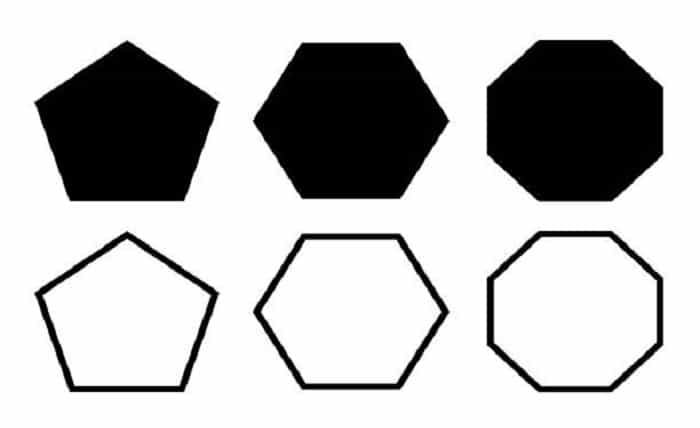Hexagon Shape: A Comprehensive Guide to Its Significance and Applications

Introduction
The hexagon shape is one of the most intriguing and versatile shapes in both nature and human-made structures. With its six equal sides and angles, the hexagon shape is not only aesthetically pleasing but also functionally efficient. From the honeycombs in beehives to modern architecture and design, the hexagon shape plays a critical role in various fields.
Understanding the hexagon shape involves exploring its mathematical properties, its occurrence in nature, and its applications in technology and art. This comprehensive guide will delve into the different aspects of the hexagon shape, highlighting why it is such a significant and widely used geometric form.
Mathematical Properties of the Hexagon Shape
The hexagon shape is a polygon with six sides and six angles. In a regular hexagon shape, all sides and angles are equal, making it a perfect example of symmetry and balance in geometry. The internal angles of a regular hexagon shape are each 120 degrees, adding up to a total of 720 degrees.
One of the unique properties of the hexagon shape is that it can be perfectly divided into six equilateral triangles. This characteristic makes the hexagon shape particularly useful in various mathematical and engineering applications. Understanding these properties is crucial for appreciating the hexagon shape’s versatility and functionality.
The Hexagon Shape in Nature
Nature frequently utilizes the hexagon shape due to its efficiency and structural integrity. One of the most well-known examples is the honeycomb, where bees construct hexagonal cells to store honey and house their larvae. The hexagon shape allows bees to maximize storage space while using the least amount of wax, showcasing the shape’s efficiency.
The hexagon shape also appears in other natural phenomena, such as the patterns on turtle shells, the structure of certain crystals, and even the cloud formations on the north pole of Saturn. These occurrences highlight the hexagon shape’s significance in nature and its role in creating stable, efficient structures.
Applications of the Hexagon Shape in Architecture
In architecture, the hexagon shape is valued for its aesthetic appeal and structural benefits. Hexagon-shaped tiles and panels are often used in flooring and wall designs, providing a visually striking and efficient use of space. The hexagon shape’s ability to tessellate without gaps makes it ideal for creating continuous, seamless surfaces.
Architects also use the hexagon shape in the design of buildings and structures to enhance stability and strength. The geometric properties of the hexagon shape allow for even distribution of stress and load, making it a popular choice in both traditional and modern architectural designs.
The Hexagon Shape in Design and Art
Designers and artists frequently incorporate the hexagon shape into their works due to its unique visual appeal and symbolic meanings. The hexagon shape is often associated with harmony, balance, and unity, making it a powerful element in visual composition.
In graphic design, the hexagon shape is used to create logos, patterns, and layouts that stand out and convey a sense of order and sophistication. The versatility of the hexagon shape allows designers to experiment with various styles and effects, making it a staple in both digital and print media.
The Hexagon Shape in Technology and Engineering
The hexagon shape plays a crucial role in technology and engineering, particularly in the design of materials and structures. For example, graphene, a single layer of carbon atoms arranged in a hexagon shape, is known for its exceptional strength and electrical conductivity. This hexagonal lattice structure is the foundation of many advanced materials and technologies.
Engineers also use the hexagon shape in the design of nuts and bolts, as it allows for easy gripping and turning with standard tools. The efficient use of space and the strength provided by the hexagon shape make it a preferred choice in various mechanical and structural applications.
Hexagon Shape in Everyday Objects
The hexagon shape is commonly found in everyday objects, from tiles and coasters to pencils and wrenches. Its prevalence is due to the hexagon shape’s practical benefits, such as maximizing space and providing a strong, stable structure. Hexagon-shaped objects are often more efficient and durable, making them a popular choice for both functional and decorative purposes.
In interior design, hexagon-shaped elements are used to create interesting and dynamic spaces. Whether through flooring, shelving, or decorative accents, the hexagon shape adds a touch of modernity and sophistication to any room.
Psychological and Symbolic Meanings of the Hexagon Shape
The hexagon shape holds various psychological and symbolic meanings across different cultures and contexts. It is often associated with harmony, balance, and unity due to its symmetrical properties. The hexagon shape’s connection to nature and its prevalence in natural structures like honeycombs also evoke feelings of efficiency, order, and productivity.
In spiritual and philosophical contexts, the hexagon shape can symbolize the interconnectedness of all things, representing the harmony and balance of the universe. Understanding these symbolic meanings can deepen our appreciation of the hexagon shape and its impact on human perception and culture.
Creating with the Hexagon Shape: DIY Projects
For those interested in DIY projects, the hexagon shape offers endless possibilities for creativity and innovation. From hexagon-shaped shelves and tables to wall art and planters, incorporating the hexagon shape into your projects can add a unique and stylish touch.
Creating with the hexagon shape involves understanding its geometric properties and applying them to your designs. Whether you are crafting with wood, metal, or paper, the hexagon shape can be adapted to various materials and techniques, making it a versatile choice for DIY enthusiasts.
Future Trends and Innovations Involving the Hexagon Shape
As technology and design continue to evolve, the hexagon shape is likely to remain a prominent feature in future trends and innovations. Advances in materials science, architecture, and engineering will continue to leverage the hexagon shape for its efficiency and strength. The growing interest in sustainable and eco-friendly design also highlights the hexagon shape’s potential in creating more efficient and resilient structures.
Innovations in digital design and 3D printing are also expected to explore new applications of the hexagon shape, pushing the boundaries of what can be achieved with this versatile geometric form. Staying informed about these trends ensures that we can appreciate and utilize the hexagon shape in new and exciting ways.
Converting CMYK to PMS (Pantone Matching System) is essential for achieving precise color consistency in print designs. While CMYK (Cyan, Magenta, Yellow, Key) is based on a subtractive color model used in color printing, PMS provides a standardized system for reproducible colors. Designers and printers often need to convert CMYK colors to PMS for branding materials, packaging, and promotional designs to ensure colors appear consistent across different media. This process involves matching the closest Pantone color equivalent for more accurate and vibrant results. Understanding this conversion helps in creating high-quality, professional designs.
Conclusion:
The hexagon shape is a fascinating and versatile geometric form that plays a significant role in various fields, from nature and architecture to design and technology. Its unique properties, aesthetic appeal, and practical benefits make it a valuable element in both functional and decorative applications. Understanding the hexagon shape’s significance and exploring its diverse applications can enhance our appreciation of this remarkable shape and inspire new ways to incorporate it into our lives.
The hexagon shape’s enduring appeal is a testament to its efficiency, beauty, and versatility. As we continue to explore and innovate, the hexagon shape will undoubtedly remain a central figure in the world of design, science, and beyond.
FAQs
1. What is the hexagon shape? The hexagon shape is a polygon with six equal sides and angles, known for its symmetry and balance. It appears frequently in nature and human-made structures.
2. Why is the hexagon shape significant in nature? The hexagon shape is significant in nature due to its efficiency and structural integrity, as seen in honeycombs, certain crystals, and other natural formations.
3. How is the hexagon shape used in architecture? In architecture, the hexagon shape is used for its aesthetic appeal and structural benefits, such as creating stable and efficient designs in flooring, tiles, and building structures.
4. What are the applications of the hexagon shape in technology? The hexagon shape is used in technology for designing advanced materials like graphene, as well as in engineering for creating strong and efficient mechanical components like nuts and bolts.
5. What are some DIY projects involving the hexagon shape? DIY projects involving the hexagon shape include creating shelves, tables, wall art, and planters, allowing for innovative and stylish home decor and functional items.




